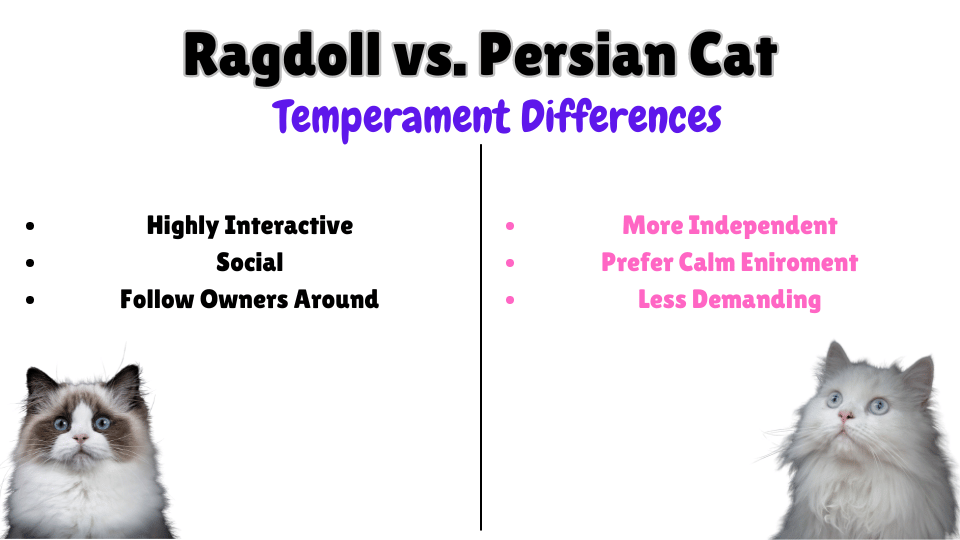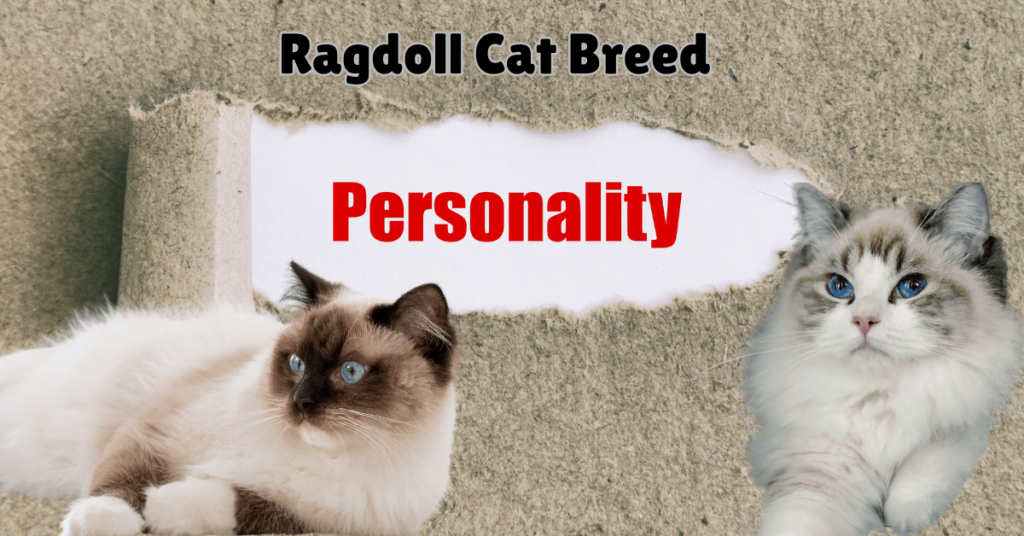This post contains affiliate links and I will be compensated if you make a purchase after clicking on my links.
Ragdoll vs. Persian Cat: A Comprehensive Introduction
If you’re torn between adopting a Ragdoll or a Persian cat, you’re in the right place. Both breeds are adored for their unique traits and affectionate natures, but they offer distinct experiences as pets. This guide aims to compare Ragdoll and Persian cats across various aspects to help you decide which feline friend is the perfect fit for your home and lifestyle.


Origins and History: Ragdoll vs. Persian Cat

Ragdoll Cats
Ragdolls are relatively new on the feline scene, created in 1963 by Ann Baker in Riverside, California. It all started with a domestic longhaired white cat named Josephine, whose offspring displayed unusually gentle and relaxed temperaments. Ann Baker capitalized on these traits, selectively breeding to create the Ragdoll we know today—large, plush, and famously floppy when picked up.
Persian Cats
Persian cats have a much more ancient pedigree. Originating from Persia (modern-day Iran), they were introduced to Europe in the 1600s and quickly became the darlings of aristocracy. Known for their luxurious coats and dignified demeanor, Persians have been selectively bred over centuries to enhance their unique physical and temperamental traits, evolving into the iconic breed we cherish today.
Physical Characteristics: Ragdoll vs. Persian Cats

Ragdoll Cats
Ragdolls are known for their large, muscular build, with males typically weighing between 15 to 21 pounds and females ranging from 8 to 15 pounds. They have an athletic appearance with long, sturdy bodies. One of the most striking features of Ragdoll cats is their captivating blue eyes, which range from light icy blue to deep sapphire, giving them an expressive and gentle look.
Ragdolls come in four official patterns: colorpoint, mitted, bicolor, and van, and their coats are available in six main point colors: seal, blue, chocolate, lilac, and cream.
Persian Cats
Persian cats have a medium to large build, with males weighing between 9 to 18 pounds and females from 6 to 14 pounds. They have a more compact and robust physique compared to Ragdolls, characterized by a broad chest and short legs, which contribute to their dignified and regal appearance.
Persian cats boast a variety of eye colors, including copper, blue, green, and even mixed hues, with their large, expressive eyes adding to their majestic look. Their long, luxurious coats come in a wide range of colors, such as silver, cream, and shaded silver.
Fact: Persians have seven different color divisions, each with various patterns and eye color possibilities, contributing to their diverse and regal appearance.
Personality and Temperament: Ragdoll vs. Persian Cat

Ragdoll Cats
Ragdolls are the epitome of a gentle giant. Known for their affectionate and social nature, they thrive on human interaction and love to be around their favorite people. These cats are often described as “puppy-like” because of their tendency to follow their owners from room to room and their enjoyment of being held and cuddled. Ragdolls are incredibly tolerant and patient, making them ideal companions for families with children and other pets.
Persian Cats
Persian cats, while equally loving, exhibit a more reserved and calm demeanor. They prefer a serene and tranquil environment where they can relax and observe their surroundings. Persians enjoy affection and will seek out their owners for a cozy cuddle session but are not as demanding of attention as Ragdolls.
Health and Lifespan: Ragdoll vs. Persian Cat

Ragdoll Cats
Ragdoll cats are generally robust but are prone to certain genetic conditions. Hypertrophic Cardiomyopathy (HCM) is a common heart condition in Ragdolls, which can lead to serious complications if not managed properly. They are also susceptible to urinary tract issues and obesity, primarily due to their laid-back nature.
Ragdoll cats typically enjoy a lifespan of 12 to 17 years. With proper care, regular vet visits, and a balanced diet, Ragdolls can live long, healthy lives.
Persian Cats
Persian cats, due to their distinctive flat faces (brachycephalic structure), often face respiratory issues, which can cause breathing difficulties.
They are also prone to dental problems, hypertrophic cardiomyopathy (HCM) (though less prevalent than in Ragdolls), and polycystic kidney disease (PKD), a genetic condition affecting kidney function. Eye care is crucial for Persians to prevent tear staining and infections, which are common due to their facial structure.
Persian cats have a similar lifespan to Ragdolls, typically ranging from 12 to 15 years. Proper care, regular veterinary visits, and a well-balanced diet can help ensure that Persian cats live long, healthy lives.
Grooming Needs: Ragdoll vs. Persian Cat

Ragdoll Cats
Ragdolls have semi-longhaired coats that are relatively low maintenance. Their fur is soft, silky, and resistant to matting, requiring brushing two to three times a week. Occasional bathing helps keep their coat clean and shiny.
Persian Cats
Persian cats boast long, luxurious coats that demands daily brushing to maintain their coat’s health and appearance. Persians also benefit from monthly baths to keep their fur clean and reduce shedding. Eye cleaning is also necessary to manage tear staining due to their facial structure.
Exercise Requirements: Ragdoll vs. Persian Cat

Ragdoll Cats
Ragdolls may be known for their laid-back nature, but they still need regular play and exercise to stay healthy and happy. These playful giants enjoy interactive toys, feather wands, and laser pointers that stimulate their natural hunting instincts. Regular play sessions help prevent obesity and keep their muscles toned. They like climbing structures and scratching posts, which also provide the physical activity they need.
Persian Cats
Persian cats prefer gentle play that matches their relaxed lifestyle. They enjoy quiet, low-energy activities such as batting at toys, chasing soft balls, or lounging on a cat tree. While they are less active than Ragdolls, it’s still important to engage them in light exercise to keep them healthy and prevent weight gain.
Adaptability and Living Environment: Ragdoll vs. Persian Cat

Ragdoll Cats
Ragdolls are highly adaptable and thrive in active households where they can be part of the action. They enjoy interacting with family members and can easily adjust to various living situations, including homes with children and other pets.
Persian Cats
Persian cats thrive in quiet households where they can relax and observe without much disruption. These cats appreciate cozy nooks and comfortable spaces where they can retreat. While they can adapt to living with other pets, they prefer calm and respectful interactions.
Ideal Diet: Ragdoll vs. Persian Cat
Both Ragdoll and Persian cats need a diet rich in high-quality protein to support muscle mass and overall health. Essential fats like omega-3 and omega-6 are vital for maintaining healthy skin and a glossy coat. Minimizing carbohydrates is important to prevent digestive issues and weight gain, as both breeds are prone to obesity due to their laid-back nature.
Ragdoll cats, being larger and more active, require a higher calorie intake compared to Persian cats. Feeding both breeds a structured schedule of two meals a day helps maintain consistent energy levels and prevents overeating. Wet food can aid in hydration and provide additional nutritional benefits, especially beneficial for Persians due to their flat-faced structure. Always ensure both Ragdoll and Persian cats have access to fresh water to maintain their health.
Fact: Both breeds need a balanced diet with the right vitamins and minerals to support their immune system and overall well-being.
Choosing the Perfect Feline Companion: Ragdoll vs. Persian Cat
Deciding between a Ragdoll and a Persian cat depends on your lifestyle and preferences. Ragdolls are perfect for those who want an affectionate, social, and interactive feline companion. They thrive in active households, enjoy being part of daily activities, and require plenty of interaction and engagement. If you have the time to provide this companionship, a Ragdoll will be a loving and loyal pet.
Persian cats, on the other hand, are ideal for individuals or families who prefer a calm, serene, and independent cat. They adapt well to various family situations and are docile enough to be around babies and seniors. Persians are comfortable spending time alone during the day, making them suitable for households where people might be away for a few hours. However, they require more time for grooming and appreciate gentle attention when you are home, including regular interaction to help them feel special and loved.
Meet Sean, a fintech whiz with a penchant for pet purrs and blockchain buzz. After a decade of fintech feats, Sean’s tech talents leaped from ledger lines to litter lines, driven by a passion for pets and a vision for a more connected pet care community. With three critter companions as co-pilots, Sean launched this blog to share a treasury of pet-friendly tech tips and tales.





